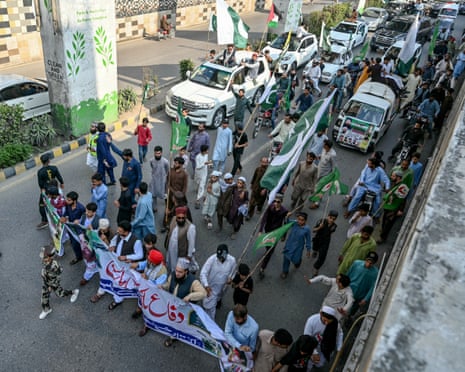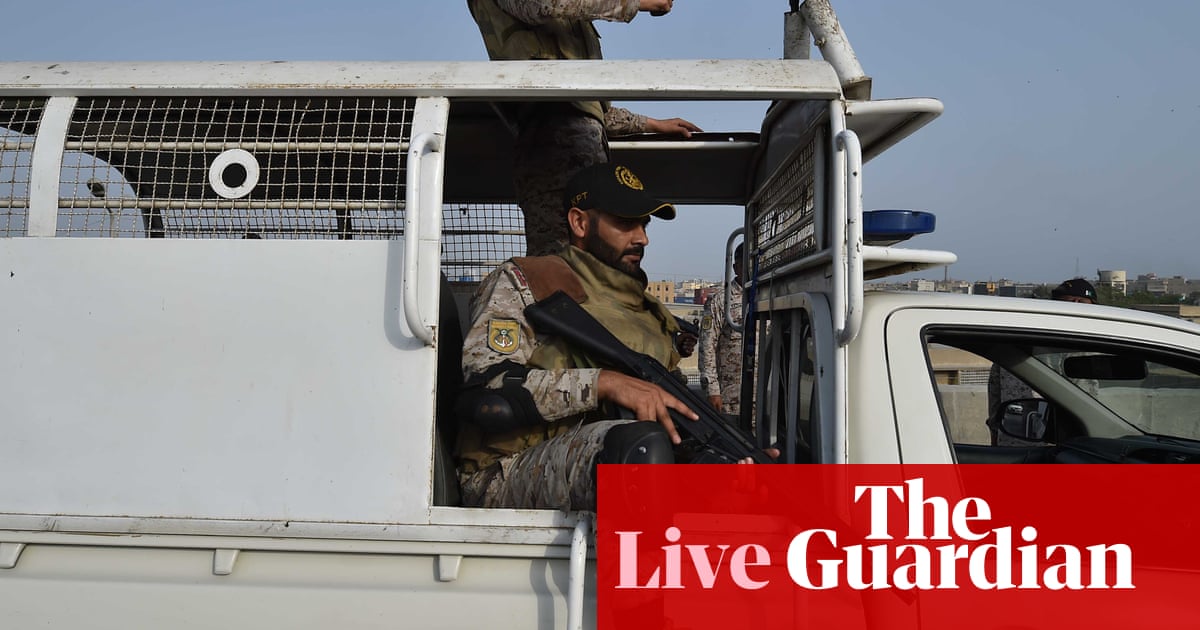Pakistan confirms counterattack against India has begun
Pakistan officials have confirmed its counterattack against India has started under the name Operation Bunyan Ul Marsoos, meaning “wall of lead” in Arabic.
As our newly updated full report says, Pakistan’s retaliatory strikes – after accusing India of targeting three of its military bases – are a major escalation of the brewing conflict between the two nuclear-armed neighbours.
Pakistan’s military spokesperson said in a live broadcast on state television early on Saturday that India had targeted Nur Khan base, Murid base and Shorkot base.
Shah Meer Baloch and Hannah Ellis-Petersen report that Nur Khan air base in Rawalpindi, where the military has its headquarters, is about 10km from the Pakistani capital, Islamabad. Video shared on social media showed flames and smoke billowing into the night sky.
The early morning strikes on Nur Khan in Rawalpindi, a densely populated area, caused mass panic, with residents running into the streets.

India’s attempted strikes on Rawalpindi and other key military bases – and the launch of Pakistan’s counterattack on Saturday – marks the steepest escalation in their confrontation yet, bringing the two countries the closest they have been to war in decades.
See the full report here:
Key events
Summary
Here’s a recap from Kate Lamb of what we know about today’s latest key developments in the intensifying India-Pakistan conflict.
-
Pakistan launched a retaliatory military operation against India early on Saturday, its military said, targeting multiple bases including a missile storage site in northern India as the nuclear-armed neighbours extended their worst fighting in nearly three decades.
-
Pakistan military officials told state-run media the Pathankot military airfield in Punjab and Udhampur air force base in Indian-administered Kashmir were among the targets, with loud explosions heard from both. Officials said the operation was called Operation Bunyan Ul Marsoos, an Arabic phrase meaning “wall of lead”.
-
Pakistan’s offensive came shortly after it said India had fired missiles from fighter jets at three air bases earlier on Saturday, including one close to the capital, Islamabad. Pakistani said its air defences had intercepted most of them.
-
Among the targets was Nur Khan air base in Rawalpindi, where the Pakistani military has its headquarters, which is around 10km from Islamabad. The strikes caused panic in the densely populated area, with loud explosions sending residents running into the streets. In the aftermath of the strikes, Pakistan shut down its air space.
-
Following Saturday’s strikes, Pakistan prime minister, Shehbaz Sharif, called a meeting of the National Command Authority, the military said. The authority is the top body of civilian and military officials that takes security decisions including those related to the country’s nuclear arsenal.
-
India’s attempted strikes on Rawalpindi and other key military bases – and the launch of Pakistan’s counter-attack on Saturday – marks the steepest escalation in their confrontation yet, bringing the two countries the closest they have been to war in decades.
-
Locked in a longstanding dispute over Kashmir, the two countries have engaged in daily clashes since Wednesday, when India launched strikes inside Pakistan on what it called militant bases.
-
At least 48 people have been killed since Wednesday, according to casualty estimates on both sides of the border that have not been independently verified.
-
The dramatic flare up comes after a deadly attack on Hindu tourists in Indian-administered Kashmir last month, when 26 civilians were killed. India has accused Pakistan of supporting militants behind the attack.
-
India’s defence and foreign ministries did not immediately comment on the strikes, but India’s military said it had actively begun large-scale mobilisation of additional forces to the border, including activating its reserve territorial army (TA), to ensure full operational strength of the army in the event of any further conflict escalation.
-
The G7 has called for an “immediate de-escalation” and “maximum restraint” between India and Pakistan amid the flaring conflict. “Further military escalation poses a serious threat to regional stability,” G7 foreign ministers said in a statement on Saturday.
Shah Meer Baloch
Pakistan’s foreign minister has said Pakistan has all options available.
Ishaq Dar, who is also deputy prime minister, told Geo News the world was watching and Pakistan had given the response.
India had left Pakistan with no choice, Dar said. The international community and friendly countries knew that Islamabad had taken this decision as a last resort.
Dar said:
In the earlier Indian attacks, our 35 civilians were killed. Hours ago, India had attacked our air force bases. We had done everything on a defensive mode and we were forced to retaliate.
It is the responsibility of the international community to play their role and they should have played their role when India had attacked Pakistan days ago and killed civilians. We showed so much restraint.
Looking now at India and Pakistan’s military might along the contested Kashmir border, the Indian army is about double the size of Pakistan’s but the two sides are “fairly evenly balanced”, says Sushant Singh, an author and political science lecturer at Yale who spent two decades in the Indian army.
There are about 1.2 million active Indian personnel compared with about 650,000 for Pakistan, Hannah Ellis-Petersen and Shah Meer Baloch report. Their dispatch continues:
Singh emphasised that, since 2020, India had deployed huge amounts of military personnel and resources towards its mountainous border with China, after the India-China border crisis swiftly escalated. India has also had issues with the modernisation of its armed forces and faced a systematic recruitment problem, leading to a shortfall of soldiers.
“Despite its size, India doesn’t have the kind of dominance where you would expect India to easily ride roughshod over Pakistan or declare a quick win,” said Singh.
The question of who would have the edge in any confrontation is also a question of equipment. In recent years, India has been shifting away from its reliance on Russian weapons to buying western munitions, including elite French Rafale jet planes and F-16 jets from the US. Pakistan now buys 80% of its military arsenal from China.
According to reports, as tensions with India rose last month, China rushed 100 more of its powerful new PL-15 missiles to Pakistan, which it usually keeps for its own inventory and does not export.
On Friday, the Pakistan army claimed it used the PL-15 missiles to bring down several Indian jets during Wednesday’s strikes. Shuja Nawaz, the author of Crossed Swords and a known expert on Pakistan’s military, said this showed that “China is not only helping Pakistan, but it is using it as a kind of testing ground for its weaponry against India”.
For more context on today’s sharp escalation of the India-Pakistan conflict, the fighting comes two weeks after New Delhi blamed Islamabad for backing an attack on the Indian-run side of disputed Kashmir that killed 26 tourists, mostly Hindu men.
India blamed the Pakistan-based Lashkar-e-Taiba – a UN-designated terrorist organisation – for the attack but Pakistan has denied any involvement and called for an independent inquiry, reports Agence France-Presse.
The countries have fought several wars over the Muslim-majority Kashmir, which both claim in full but administer separate portions of since gaining independence from British rule in 1947.
Previous clashes have been mostly limited to the Kashmir region – separated by a heavily militarised border known as the line of control – but this time India has struck multiple cities deep in Pakistan.
Pakistan’s foreign ministry alleged New Delhi’s “reckless conduct has brought the two nuclear-armed states closer to a major conflict”.
India’s prime minister, Narendra Modi, met top security officials on Friday, including his national security advisor, defence minister and the chiefs of the armed forces, his office said.
India starts large mobilisation of extra troops to border, says military

Hannah Ellis-Petersen
The Indian military says it has actively begun large-scale mobilisation of additional forces to the border, including activating its reserve territorial army (TA), to ensure full operational strength of the army in the event of any further conflict escalation.
In a notification on Friday amid the escalating tensions between India and Pakistan, the Indian ministry of defence announced the activation of 14 of 32 infantry battalions of the TA for deployment across the country until February 2028.
Each TA battalion has about 750 personnel.
Shah Meer Baloch
The Pakistani military has posted a video on X of its first military strike against India that was launched before dawn after Indian missile attacks on Pakistan’s three air force bases.
A senior security source requesting anonymity said Pakistan was left with no choice to take retaliatory actions after it was forced by Indian military aggression but that the early morning attacks on the Pakistani air bases were unprecedented.
The security official said:
Indian missile attacks were a very serious escalation. It is unprecedented. We have not seen such escalation since the 1971 war with India. We have been defensive since the start of the conflict, but India now wants to become offensive. We have given our response.
Who is Asim Munir, the army chief leading Pakistan’s military amid the crisis with India?
The general once fell foul of Imran Khan, but since taking the top spot has been quietly amassing power over the government and supreme court, as our profile here says.
Hannah Ellis-Petersen and Shah Meer Baloch report that in the 77 years since Pakistan was established, its affairs and politics have long been governed by the whims of powerful military generals.
Yet even now that the country is out of the clutches of martial law, it is still widely understood that the most powerful man in Pakistan is not the head of the government but instead the chief of the army.
Since Gen Munir took over as Pakistan’s army chief more than two years ago, he has been accused of quietly consolidating greater power without even having to topple the country’s civilian rulers. As he kept himself largely out of the limelight, he consolidated an iron grip over the army’s ranks and bent government policy and even the supreme court to his will.
You can read more on Munir here:
More here on the G7 urging an “immediate de-escalation” and “maximum restraint” between India and Pakistan amid the flaring conflict between the nuclear-armed neighbours.
“Further military escalation poses a serious threat to regional stability,” the foreign ministers of the Group of Seven wealthy democracies said in a statement, cited by Agence France-Presse.
The G7 – which includes Japan, Canada and Italy as well as the US, the UK, Germany and France – added that both sides should “engage in direct dialogue towards a peaceful outcome”.
Here are some of the latest images coming in from Pakistan, showing police removing vehicles and people from the main entry of Nur Khan airbase after the Indian missile strike in Rawalpindi on Saturday.
Pakistan confirms counterattack against India has begun
Pakistan officials have confirmed its counterattack against India has started under the name Operation Bunyan Ul Marsoos, meaning “wall of lead” in Arabic.
As our newly updated full report says, Pakistan’s retaliatory strikes – after accusing India of targeting three of its military bases – are a major escalation of the brewing conflict between the two nuclear-armed neighbours.
Pakistan’s military spokesperson said in a live broadcast on state television early on Saturday that India had targeted Nur Khan base, Murid base and Shorkot base.
Shah Meer Baloch and Hannah Ellis-Petersen report that Nur Khan air base in Rawalpindi, where the military has its headquarters, is about 10km from the Pakistani capital, Islamabad. Video shared on social media showed flames and smoke billowing into the night sky.
The early morning strikes on Nur Khan in Rawalpindi, a densely populated area, caused mass panic, with residents running into the streets.
India’s attempted strikes on Rawalpindi and other key military bases – and the launch of Pakistan’s counterattack on Saturday – marks the steepest escalation in their confrontation yet, bringing the two countries the closest they have been to war in decades.
See the full report here:
Pakistan closes airspace – report
Pakistan has shut its airspace to all air traffic, India’s NDTV is reporting.
Pakistan’s military says it has hit India’s Pathankot air field, Udhampur air force station and Brahmos missile site, Reuters reports.
Pakistan targeting ‘multiple’ Indian locations in retaliatory strikes – state media
State-run Pakistan Television says “multiple locations” in India are being targeted in Pakistan’s retaliatory attacks.
It did not give details and it was unclear which military locations in India were being targeted.
The report from the Associated Press comes after Pakistan’s army said earlier that India had fired missiles at three air bases in the country. Most had been intercepted, it said.
Pakistan launches retaliatory strikes against India – report
Pakistan has launched retaliatory military action against India, the Pakistani state broadcaster has said, citing security sources.
Multiple explosions have been heard in the Indian cities of Amritsar and Jammu, according to Reuters witnesses, and in the north-western Pakistani city of Peshawar.
G7 countries have called for an immediate de-escalation between India and Pakistan and encouraged them to engage in direct dialogue towards a peaceful outcome, Reuters is reporting.
The Group of Seven includes the US, UK, France and Germany.
Welcome
Hello and welcome to our coverage of the India-Pakistan crisis.
Pakistan’s army spokesman says India has fired missiles at three air bases inside the country, but most of the missiles have been intercepted.
Lt Gen Ahmad Sharif said all Pakistan air force assets were safe.
He made this announcement during his televised address, saying some of the Indian missiles had also hit India’s eastern Punjab.
The news comes after Pakistan was accused of launching a fresh wave of drone strikes against India, with projectiles reported over the states of Indian-administered Kashmir and Punjab.
The allegations were yet another alarming confrontation between India and Pakistan, two nuclear-armed countries, since India’s missile strikes on nine sites in Pakistan on Wednesday killed 31 people. Those strikes in turn were India’s response to an attack in Indian-administered Kashmir late last month, in which militants killed 25 Hindu tourists and a guide.
Follow the developments with us.

